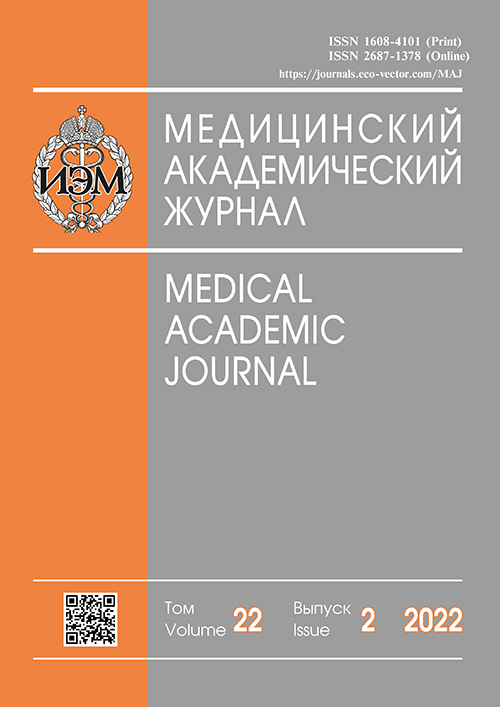Выявление иммуноглобулинов, специфичных к S-белку вируса SARS-CoV-2, в смешанной слюне
- Авторы: Лизункова М.А.1, Кударь П.А.2, Королёва И.В.1,2, Дешева Ю.А.1,2
-
Учреждения:
- Санкт-Петербургский государственный университет
- Институт экспериментальной медицины
- Выпуск: Том 22, № 2 (2022)
- Страницы: 209-214
- Раздел: Материалы конференции
- Статья опубликована: 06.11.2022
- URL: https://journals.eco-vector.com/MAJ/article/view/108961
- DOI: https://doi.org/10.17816/MAJ108961
- ID: 108961
Цитировать
Полный текст
Аннотация
Обоснование. С начала пандемии COVID-19 ученые обеспокоены поиском эффективной альтернативной диагностики антител к SARS-CoV-2 на основе крови. Многочисленные исследования отечественных и зарубежных авторов подтверждают: слюна — ценный диагностический материал. Так, использование смешанной слюны открывает широкие возможности диагностики COVID-19 для уязвимых групп населения, например детей, потому что методика забора материала безболезненна и неинвазивна.
Цель исследования — разработка методики для выявления иммуноглобулинов, специфичных к вирусу SARS-CoV-2, в слюне после инфекции COVID-19 и вакцинации.
Материалы и методы. В исследовании приняли участие 43 человека от 20 до 67 лет, разделенные на три группы: перенесшие COVID-19; считающие, что не болели COVID-19; вакцинированные различными препаратами против COVID-19. От каждого испытуемого получены пробы нестимулированной смешанной слюны и капиллярной крови из пальца, которые впоследствии изучали методами качественного и количественного иммуноферментного анализа.
Результаты. Продемонстрирован высокий уровень корреляции содержания локальных IgG и IgA в слюне, при этом между содержанием IgA в крови и слюне показана взаимосвязь средней силы. Продемонстрировано большее число (по сравнению с переболевшими COVID-19) серопозитивных пациентов в группе привитых вакцинами против SARS-CoV-2, что согласуется с данными анамнеза.
Заключение. Настоящая работа экспериментально подтверждает, что слюна в составе ротовой жидкости — ценный диагностический материал для изучения локальных антител. Полученные данные позволят разработать уникальные тест-системы для изучения гуморального иммунитета к вирусу SARS-CoV-2, которые могут стать альтернативой привычному определению вирусспецифических иммуноглобулинов в крови.
Ключевые слова
Полный текст
Об авторах
Маргарита Алексеевна Лизункова
Санкт-Петербургский государственный университет
Автор, ответственный за переписку.
Email: margaalekseevna@gmail.com
врач-стоматолог, клинический ординатор
Россия, Санкт-ПетербургПолина Андреевна Кударь
Институт экспериментальной медицины
Email: polina6226@mail.ru
младший научный сотрудник
Россия, Санкт-ПетербургИрина Владимировна Королёва
Санкт-Петербургский государственный университет; Институт экспериментальной медицины
Email: ivkoroleva@yandex.ru
ORCID iD: 0000-0002-7966-5130
SPIN-код: 6456-7406
канд. биол. наук, заместитель заведующего кафедрой фундаментальных проблем медицины и медицинских технологий по учебно-методической работе; старший научный сотрудник отдела молекулярной микробиологии
Россия, Санкт-Петербург; Санкт-ПетербургЮлия Андреевна Дешева
Санкт-Петербургский государственный университет; Институт экспериментальной медицины
Email: desheva@mail.ru
ORCID iD: 0000-0001-9794-3520
SPIN-код: 4881-3786
Scopus Author ID: 9939567500
ResearcherId: I-1493-2013
д-р мед. наук, профессор кафедры фундаментальных проблем медицины и медицинских технологий; ведущий научный сотрудник отдела вирусологии
Санкт-Петербург; Санкт-ПетербургСписок литературы
- Muralidar S., Ambi S.V., Sekaran S., Krishnan U.M. The emergence of COVID-19 as a global pandemic: Understanding the epidemiology, immune response and potential therapeutic targets of SARS-CoV-2 // Biochimie. 2020. Vol. 179. P. 85–100. doi: 10.1016/j.biochi.2020.09.018
- Varghese P.M., Tsolaki A.G., Yasmin H. et al. Host-pathogen interaction in COVID-19: Pathogenesis, potential therapeutics and vaccination strategies // Immunobiology. 2020. Vol. 225, No. 6. P. 152008. doi: 10.1016/j.imbio.2020.152008
- Suvorov A., Gupalova T., Desheva Yu. et al. Construction of the enterococcal strain expressing immunogenic fragment of SARS-Cov-2 Virus // Front. Pharmacol. 2021. Vol. 12. P. 807256. doi: 10.3389/fphar.2021.807256
- Брещенко Е.Е., Быков И.М. Биохимия полости рта, ротовой и десневой жидкостей: учебно-методическое пособие. Краснодар, 2018.
- Быков В.Л. Гистология и эмбриональное развитие органов полости рта человека: учебное пособие. Москва: ГЭОТАР-Медиа, 2014.
- Kato A., Hulse K.E., Tan B.K., Schleimer R.P. B-lymphocyte lineage cells and the respiratory system // J. Allergy Clin. Immunol. 2013. Vol. 131, No. 4. P. 933–957. doi: 10.1016/j.jaci.2013.02.023
Дополнительные файлы






